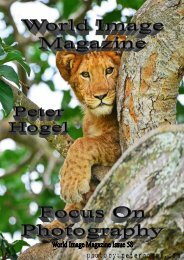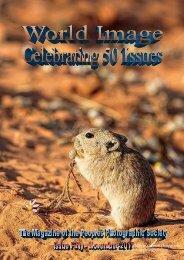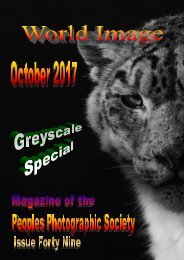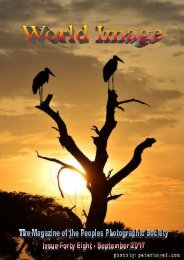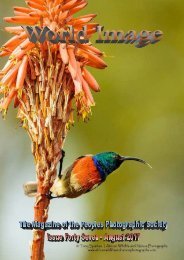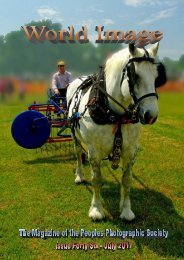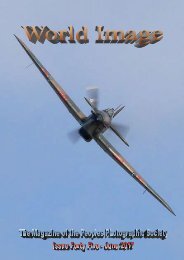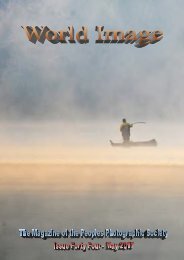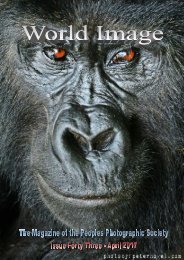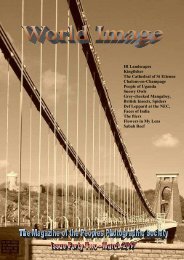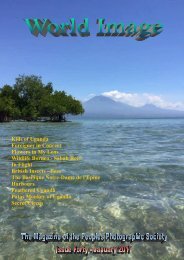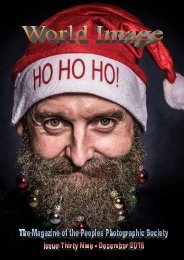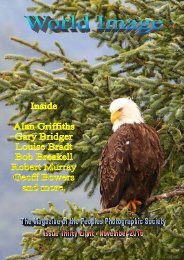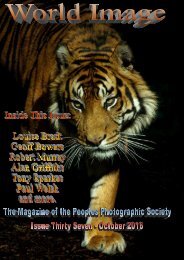World Image issue 30 March 2016_1
You also want an ePaper? Increase the reach of your titles
YUMPU automatically turns print PDFs into web optimized ePapers that Google loves.
Website = photosociety.net Page 1 email = magazine@photosociety.net
Management Team<br />
Gordon Longmead - England - CEO<br />
Peter Hogel - Uganda - Deputy CEO<br />
Scott Hurd - Namibia<br />
Tom Coetzee - South Africa<br />
Paul Welch—Australia<br />
Steve Cook - USA<br />
Robert Murray - Scotland<br />
Rabi Chandra Pokharel - Nepal/Himalayas<br />
Tina Andreasson - Sweden and Mexico<br />
Jack Glisson - Kentucky USA<br />
Rodger Lee - Steam Punk Events<br />
In This Issue<br />
3 Monthly Challenge Competition January <strong>2016</strong> - Lets Go Potty<br />
4 Monthly Challenge Competition February <strong>2016</strong> - Stone Masons Challenge<br />
6 Wild Horses of Namibia by Pictures by Scott Hurd<br />
8 Uganda, Murchison Falls National Park - By Gordon Longmead<br />
14 A Study in Nature - Pictures by Scott Latham<br />
15 A Black and White Exercise by Rodger Lee<br />
16 Photoart by Gordon Longmead<br />
17 Winter Chills<br />
18 Cuddling the Cheetahs… by Peter Hogel<br />
20 Wildlife of the <strong>World</strong>, Birds of a Feather - On The Wing<br />
22 A Study in Greyscale - Zoo Animals, New Context - Pictures by Alan Griffiths<br />
23 Nasty or Nice, The Rhino by Felix Paton for the Ziwa Rhino Trust<br />
27 Moon and Night Sky<br />
28 Animal Magic - Non-Wildlife<br />
<strong>30</strong> Wildlife Borneo - Another Day in Paradise 2 - Sabah Reef by Gary Bridger<br />
32 The Kalahari [Also known as the Kalagadi] by Ian Bales-Smith<br />
38 A Study in Nature- Badgers in Greyscale, Pictures by Scott Latham<br />
39 Brooks Medival Faire, Alberta, Canada, Pictures by Bob Breakell<br />
40 Wildlife of the <strong>World</strong> - Land Animals<br />
42 A Study in Music Photography - Def Leopard Pictures by Alan Griffiths<br />
44 Personable Portraiture - Candid Pictures<br />
46 The Water Cycle - Rain to River to Seas to Rain<br />
48 Dinner Time<br />
49 The Netherlands, Ardennes, Part 1, tracks to follow by Paul Weijenberg<br />
52 City of London at Night by Philip Moore<br />
<strong>World</strong> <strong>Image</strong> Magazine on Fine Art America<br />
Peoples Photographic Society Member galleries<br />
http://gordon-longmead.artistwebsites.com/index.html?tab=galleries<br />
As part of the expansion and ongoing development of the <strong>World</strong> <strong>Image</strong><br />
Magazine, we have established a website presence within Fine Art<br />
America for the presentation and promotion, and sale of member images.<br />
Members wishing to add their own gallery should contact Gordon@worldimagemag.co.uk for details.<br />
© Please remember that all articles and images published in this magazine are copyright protected<br />
Cover Picture - Reflections<br />
Website = photosociety.net Page 2 email = magazine@photosociety.net
Monthly Challenge Competition January <strong>2016</strong><br />
Lets Go Potty<br />
2nd Peter Hogel<br />
1st Georgene Bergstrom<br />
4th Matthew Brooks<br />
3rd Alan Culley<br />
Website = photosociety.net Page 3 email = magazine@photosociety.net
Monthly Challenge Competition<br />
Newcomers submitting to the competition<br />
by email, will be registered with the<br />
society.<br />
The top four monthly entries will be<br />
selected by the editor or nominee, neither<br />
they, or their families may enter the<br />
competitions.<br />
Challenges will end at mid day (GMT) on<br />
the last day of each month and the ‘best’<br />
four will be selected and points awarded<br />
and certificates <strong>issue</strong>d.<br />
I am pleased to advise you all that Fujifilm have<br />
donated a Fuji X<strong>30</strong> camera valued at £<strong>30</strong>0 for the<br />
winner of the <strong>2016</strong> Monthly Challenge, which will<br />
be awarded to the overall winner after the December<br />
Competition. For reviews and specs just search<br />
online for ‘Fuji X<strong>30</strong>’.<br />
Entries should be posted in the facebook PPS or<br />
<strong>World</strong> <strong>Image</strong> group, or, for those not in facebook,<br />
j p g f i l e s s h o u l d b e s e n t t o<br />
lendasnow@hotmail.co.uk and titles for the relevant<br />
competition.<br />
The league table and the winning entry will be<br />
published in the Magazine of January 2017.<br />
The judging is based on adherence to the challenge<br />
title and the skills of the photographer in their<br />
interpretation of the subject.<br />
The Current challenge which ends on the 31st<br />
<strong>March</strong> is - 'Wood You Believe It' . This is all about<br />
wood and woodlands and is only limited by your<br />
imagination and skills.<br />
Monthly Challenge Competition February <strong>2016</strong><br />
Stone Masons Art<br />
First place in the<br />
February Challenge is<br />
awarded to<br />
Zlatan Celebic<br />
for<br />
The Temple of Artemis<br />
While the picture displays<br />
the skill and artistry of the<br />
stone mason, it also conveys<br />
the feeling of strength and<br />
power by the manner in<br />
which the image has been<br />
taken.<br />
Artemis is the patron goddess<br />
of Gerasa (Jerash), Jordan. It<br />
was said the temple was<br />
never completed, only 12<br />
columns, out of 32 planned,<br />
were erected.<br />
Website = photosociety.net Page 4 email = magazine@photosociety.net
Second Place - Philip Moore<br />
Third Place - Robert Murray<br />
Fourth Place - The Lincoln Imp by Geoff Bowers<br />
Website = photosociety.net Page 5 email = magazine@photosociety.net
Wild Horses of Namibia<br />
Pictures by Scott Hurd<br />
The wild horses of Namibia, the<br />
Namib Horses, are feral horses<br />
found in the Namib Desert of<br />
Namibia, Africa.<br />
With a current population of less<br />
than 200 and drout conditions, they<br />
are in danger of extinction.<br />
Website = photosociety.net Page 6 email = magazine@photosociety.net
They are believed to be the descendants of the<br />
European light riding horses abandoned during<br />
the great wars.<br />
These feral horses were able to develop in<br />
almost complete isolation having lived in this<br />
area for more than 100 years and without any<br />
human assistance.<br />
If you would like to help support the horses of the<br />
Namib, please contact Scott Hurd by email.<br />
Website = photosociety.net Page 7 email = magazine@photosociety.net
Uganda<br />
Murchison Falls National Park - Part Three<br />
To the north of the Victoria Nile By Gordon Longmead<br />
So temporarily leaving the placid waters of the<br />
Victoria Nile behind us from the last <strong>issue</strong> (we<br />
return to look at the birds in the next <strong>issue</strong>), we<br />
ventured into the northern part of the park. It was<br />
not long before Peters knowledge of Murchison<br />
produced the photographic opportunities.<br />
We were in the park over a three day period<br />
stopping at a nearby safari lodge for the two<br />
intervening nights.<br />
Before we get into the article I will say that the<br />
pictures are not in any particular order. The main<br />
reason being that the animals are free to roam and<br />
will not be seen in the same sequence or place on<br />
two consecutive occasions.<br />
It is not advisable to drive into the center of the herd<br />
as the matriarch or bull will probably object and will<br />
defend their family.<br />
Starting with the largest land animal in the park and<br />
a favourite of most people, there a number of<br />
elephant herds in Murchison.<br />
We came close to two of the larger herds, one of the<br />
bull elephants was standing in the road as we<br />
approached.<br />
He watched us to ensure we were not a threat while<br />
the herd crossed the road.<br />
We need to remember that these are large and<br />
potentially dangerous animals, they have feelings<br />
and are very protective of their herd members.<br />
Website = photosociety.net Page 8 email = magazine@photosociety.net
The second herd we met on the road was much<br />
larger, and potentially much more dangerous as they<br />
had young in their number. As you can see they had<br />
teenagers and calf's.<br />
That being said I think this herd were so surprised at<br />
seeing us they became curious and after the herd<br />
joined forces on one side of the road, (we waited<br />
until they had finished crossing the road), they just<br />
stood aside and watched us as we passed.<br />
The elephant is not the only animal that roams the<br />
park as a herd, the Water Buffalo also has a major<br />
presence in the park.<br />
While we see many individuals and pairs roaming<br />
the park as we drive through, turning a corner on<br />
one of the less travelled roads and being greeted<br />
with a herd in excess of 200 strong is quite a<br />
spectacle.<br />
The fact that these beasts are aggressive and that we<br />
had to drive through the middle of the herd does<br />
little to calm the nerves.<br />
Another of the herding animals, although not in such<br />
large numbers, is the Giraffe. Again there are many<br />
individuals and pairs roaming the park, but the first<br />
herd we encountered numbered 12 individuals.<br />
I am advised that the darker markings on the giraffe<br />
indicate an older animal which made this one the<br />
oldest in this group.<br />
Website = photosociety.net Page 9 email = magazine@photosociety.net
Soon after our meeting with this small gathering of<br />
giraffe we met up with a larger group, this time they<br />
were not at a distance but all around the car.<br />
It was nice to see a young calf with its mother even if<br />
the calf was too small to reach the tree.<br />
This herd numbered 18 individuals and were on both<br />
sides of the road. In fact they surrounded the car so<br />
we turned off the engine.<br />
I am guessing that it was the same pair we saw<br />
running across the road the following day. Seeing<br />
them run with such grace is a beautiful sight.<br />
On our last day in Murchison we encountered<br />
another herd and stopped to watch them. Well not so<br />
much through choice as the bull was standing in the<br />
road.<br />
Having checked us out from both sides they were in<br />
no hurry to move away, so we stood outside to take<br />
pictures and video of the group.<br />
This giraffe stayed in the same spot and watched<br />
what we were doing until most of the herd had<br />
crossed the road. As in all families there are always<br />
those who refuse to obey the boss.<br />
Website = photosociety.net Page 10 email = magazine@photosociety.net
These two juveniles were so interested in their<br />
practice / display of neck fighting. This was just<br />
practice, the real thing is both brutal and dangerous<br />
and used in territorial fights.<br />
Although the warthog is often seen as an individual<br />
character, most of those in Murchison are in family<br />
groups.<br />
We remained here for some time before the herd<br />
started to move away. We remained under the<br />
watchful eye of the boss until all the animals passed<br />
us by before leaving himself.<br />
Of course all of the herds, like the other animals, eat<br />
grass, but when we consider that they eat tons of<br />
grass at one end, the mind boggles at what comes out<br />
the other.<br />
We have seen the hippo (Hippopotamus amphibius)<br />
in the lakes and ponds with its eyes peeping above<br />
the water, the treat is to see it on land.<br />
So enter one of natures recycling crews, the dung<br />
beetle (Scarabaeinea). The dung beetle is possibly<br />
natures most efficient waste disposal unit. It uses the<br />
dung balls as nursery pods and the residue serves to<br />
fertilize the soil.<br />
The Warthog (Phacochoreus africanus) is another of<br />
the most prolific animals in the park. It can be seen as<br />
individuals and as family groups, the largest groups I<br />
saw were two adults and two youngsters and one<br />
adult and three piglets.<br />
It is a wild pig and is so named because of the<br />
protuberances on its face.<br />
It is also noted that is is comparable in size to the<br />
elephant and when ever seen on land, is usually<br />
accompanied by a pair of opportunistic egrets.<br />
While the female can weigh up to 5,160lb (2344kg),<br />
the male can reach 7000lb (3,200kg), and their hide<br />
can be 4.5cm thick. It can also run at 19mph, which<br />
is about three times faster than most humans can<br />
sprint.<br />
Website = photosociety.net Page 11 email = magazine@photosociety.net
Jacksons Hartebeest (Alcelaphus buselaphus jacksoni)<br />
The Jacksons Hartebeest is seen in large numbers in<br />
Murchison.<br />
The Female Kob<br />
The Waterbuck (Kobus ellipsiprymnus) is a large<br />
antelope with a shaggy coat. It is the largest of the<br />
Kobus, the male of which can be aggressive.<br />
Bushbuck (Tragelaphus scriptus)<br />
The Bushbuck (Tragelaphus scriptus) is a medium<br />
sized, antelope. Although very common its secretive<br />
nature makes it harder to spot.<br />
Uganda Kob (Kobus kob thomasii)<br />
The Uganda Kob is Uganda's national antelope. It is<br />
most abundant in the area of Murchison Falls and<br />
the Queen Elizabeth national park.<br />
Waterbuck (Kobus ellipsiprymnus) male<br />
The males harem can have up to ten females which<br />
he fiercely defends against interlopers.<br />
Website = photosociety.net Page 12 email = magazine@photosociety.net
Waterbuck (Kobus ellipsiprymnus) female<br />
The various antelope are numerous through out<br />
Murchison and one of the most difficult problems<br />
for the novice, and possibly the experienced, is the<br />
certain identification of the different species. This<br />
one is a case in point.<br />
Some have many varieties within the species, while<br />
others are to young to have gained the distinguishing<br />
markings.<br />
But one thing is certain, when, like me, you visit for<br />
the first time you take everything in sight, next visit<br />
I will be looking for the unusual pictures we can get<br />
from watching the behaviour.<br />
The images here are by no means the whole story<br />
there are many more animals and birds to discover,<br />
but I will leave that for another time.<br />
Next <strong>issue</strong> I will be looking at the birds of the<br />
Victoria Nile and Murchison generally.<br />
Gordon<br />
Some are easy to distinguish close up, but at a<br />
distance you need a very experienced guide.<br />
Website = photosociety.net Page 13 email = magazine@photosociety.net
A Study in Nature - Nuthatch, Dunnock and Grey Wagtail<br />
Pictures by Scott Latham<br />
Four of the Nuthatch<br />
Dunnock<br />
Grey Wagtail<br />
Website = photosociety.net Page 14 email = magazine@photosociety.net
A Black and White Exercise<br />
Rodger Lee<br />
When we use photography to look at buildings, there are two areas that gravitate towards, the new shiny<br />
modern glass structures with their formal style and reflections, or the old character buildings which have a<br />
character and old world charm all of their own.<br />
Britain has its fair share of both, and in this study by Rodger Lee, the focus is on the old and decrepit. These<br />
were all taken in the area around Doncaster, but such structures can be found in most places from the<br />
smallest village to the largest city.<br />
Although these are general shots, if you look at the pictures you will see many other possible pictures within<br />
them. That is part of the photographers art, not just to see the overview, but to see beyond it to the finer<br />
opportunities that may be lurking in the picture.<br />
Website = photosociety.net Page 15 email = magazine@photosociety.net
Photoart<br />
Gordon Longmead<br />
There is much discussion about the validity of<br />
Photoart as a part of photography. Photography is an<br />
art form, one in which the photographer holds the<br />
same position as any artist in history.<br />
When we look at Constables ‘The Haywain’ no one<br />
ever complains that the cart was not in the river<br />
when the picture was painted. No one ever criticises<br />
the glamorised portraits that hang in galleries across<br />
the world.<br />
Artists paint the scene in their studio from general<br />
sketches and memory, the lighting is created in the<br />
studio, even in the open the lighting is fixed at the<br />
start of the painting but changes during the day, a<br />
change ignored by the artist.<br />
The artist is only interested in the end result. If<br />
painting a portrait, the artist glamorises the subject<br />
to hide the blemishes and make the subject feel good<br />
about themselves.<br />
In this image The main subject is a straight<br />
photograph, but I wanted it to tell a story. In this<br />
instance the story is a simple one, “Here we are on<br />
Earth and just beyond the horizon is the maelstrom<br />
that is space, and it is coming our way.”<br />
Hidden with the view is a second story, “The<br />
maelstrom is of our own making and is slowly but<br />
surely consuming the natural Earth.”<br />
Photoart is the vision you have in your heart at the<br />
moment the image is created, be it a portrait of a<br />
woman or a scene of fire and brimstone.<br />
Do not hide behind the false purist belief that<br />
photography is nothing more then a record of what<br />
is.<br />
Photography has many faces, record photography is<br />
just one of them, any fool can take a picture, a<br />
photographer produces artworks.<br />
Website = photosociety.net Page 16 email = magazine@photosociety.net
Winter Chills<br />
Last month we hoped for some more pictures for the<br />
Winter Chills series, and we have not been left in<br />
the cold.<br />
With the changing weather patterns the images of<br />
winter begin to alter as well. Snow in the desert,<br />
heat waves (anything above -40) in the arctic, and<br />
the opportunities for the cold pictures come and go<br />
for many people.<br />
Pictures of the cold are not restricted to the snow<br />
covered landscapes and ice fountains.<br />
This builds up over time and becomes compacted<br />
into ice at the lower depths. As snow continues to<br />
build on the surface the pressure causes the base of<br />
the ice to start moving, forming the glaciers.<br />
One of the most spectacular sights of winter are the<br />
Hoar frosts also known as Soft Rime,. The pictures<br />
above and below are just such taken be Bob<br />
Breakell in Canada.<br />
The picture above was taken by Gordon Longmead<br />
is the Eiger Glacier taken from the Jungfrau in the<br />
Alps. Sadly, many of the glaciers that we knew 50<br />
years ago have melted away due to those<br />
aforementioned changes in weather patterns. And<br />
Finally, lets not forget the wildlife, they feel the cold<br />
as well.<br />
We all know of the smooth ice formed by freezing<br />
water on a cold surface, but with Hoar frost, the<br />
crystalline ice structures grow directly from water<br />
vapour from air, a process that turns the vapour to<br />
ice without going through the water stage.<br />
Glaciers are a different matter, they form at high<br />
altitude from snow fall.<br />
Female Downy Woodpecker<br />
Website = photosociety.net Page 17 email = magazine@photosociety.net
Cuddling the Cheetahs…<br />
Peter Hogel<br />
Let’s get a couple of things straight from the<br />
beginning…<br />
Who am I, Wildlife guide and wildlife photographer<br />
in Uganda and when the voices in my head speak to<br />
me they do it with a voice of Gorillas, birds, crickets<br />
and a serenade of other wildlife. I do not like wild<br />
animals as pets or in a zoo, however, that said…<br />
UWEC, Uganda Wildlife Educational Center, some<br />
might call it a zoo, but it does work as an<br />
educational center for anyone who wants education<br />
that has to do with wildlife and animals.<br />
It also has the most important task to educate school<br />
kids in Uganda, about animals and how, and why,<br />
they need to co-exist, a crucial piece in the jigsaw<br />
puzzle of wildlife conservation.<br />
So I do try to help in my way, take photos,<br />
document and “spread the word” that’s what we did<br />
before we could “share”.<br />
Website = photosociety.net Page 18 email = magazine@photosociety.net
So here they are, now about 11 months old, strong<br />
and with sharp teeth and claws…and very playful.<br />
So every once in a while I find myself behind the<br />
scenes of UWEC, getting the sherry of the cake,<br />
getting close to some of those animals that I<br />
normally keep on an arm’s length, without giving<br />
them my arm so to speak.<br />
They are used to people, their “keeper” and tourists<br />
that pay for the behind the scenes tour, money goes<br />
to running the center and hopefully a new cat<br />
enclosure, eventually…<br />
So I had some good time to get up close, they like to<br />
nibble on my fingers, but don’t bite, well not<br />
intentionally anyway, they have a “sharp” mind and<br />
are not pets, so even if we consider them as safe to<br />
handle, they like to sneak up from behind and breath<br />
down your neck, so one shouldn’t relax too much.<br />
It’s a privilege to get so close to these cats, not many<br />
people do…and live to tell about it, LOL… but here<br />
we can, and if you do pas by Uganda, you should<br />
definitely stop by!<br />
This time, it was cuddling with the cheetahs, the two<br />
slender cats are siblings from north eastern Uganda,<br />
found abandoned or survived from poachers when<br />
they were just a few weeks, they were brought to<br />
UWEC and survived, what happened to their mom<br />
we don’t know.<br />
I’ve been around this place for some time now, and I<br />
won’t argue with the fact that animals shouldn’t be<br />
locked up, they should run free…however, we do<br />
come across animals way to often that needs our<br />
help, and unfortunately some don’t have the option<br />
to be able to be reinstated in their natural habitat, at<br />
least here they can stand for the fight against<br />
poachers, and lead the roll of educating people, and<br />
that does make a difference. I must say, the animals<br />
at UWEC do have as good life as it can be, they are<br />
well taken care of in a good environment, well we<br />
do need a new cat enclosure…bigger.<br />
Peter Hogel<br />
Website = photosociety.net Page 19 email = magazine@photosociety.net
Wildlife of the <strong>World</strong><br />
Birds of a Feather - On The Wing<br />
Of all the aspects involved with bird photography<br />
probably the most difficult to master is the capture<br />
of a bird in flight.<br />
The Eagle Has Not Landed by Tom Coetzee<br />
More often than not the bird is too far away to get<br />
any meaningful image. Most appear as black<br />
silhouettes against the sky.<br />
As for the former problem we can only recommend<br />
patience, a long lens and a steady hand. The latter<br />
problem is easier to resolve. When taking birds in<br />
flight or against a sky background, alter the camera<br />
settings to +3 the f-stop.<br />
African Fish Eagle by Gordon Longmead<br />
There are two good reasons for this, the first is that<br />
you stand more chance of capturing the ‘moment’<br />
and the second is that the second and subsequent<br />
image in a series will have less camera shake. This<br />
is because you only press the shutter once so the<br />
camera only moves once.<br />
African Fish Eagle by Gordon Longmead<br />
This convinces the camera that the now over<br />
exposed picture is a correct exposure, and of course<br />
it probably is for the bird. Remember to alter the<br />
camera back for other pictures.<br />
It is also worth while setting the camera for repete<br />
shooting to catch the sequence of the flight.<br />
In Flight by Karim Ahmed<br />
Website = photosociety.net Page 20 email = magazine@photosociety.net
Some birds are easier to photograph in flight than<br />
others. One not so easy subject is the Peregrine<br />
Falcon in a 180mph dive. Others twist and turn so<br />
mush that keeping them in frame is the problem.<br />
Sunbird approaching nest was shot at Nunmanglam<br />
reserve Forest by Nam Prasad Satsangi<br />
But patience and perseverance will be rewarded. I<br />
suppose the easiest time to catch the birds on the<br />
wing, is as they come to land or as in the image<br />
above, need to hover to feed their young. This is the<br />
time when they are moving at their slowest.<br />
Positioning is always a bonus and the right position<br />
can create stunning results.<br />
Gordon<br />
Osprey in Kelowna, British Columbia, Canada<br />
by Bob Breakell<br />
The Approach by Karim Ahmed<br />
Website = photosociety.net Page 21 email = magazine@photosociety.net
A Study in Greyscale - Zoo Animals, New Context<br />
Pictures by Alan Griffiths<br />
Website = photosociety.net Page 22 email = magazine@photosociety.net
Website = photosociety.net Page 23 email = magazine@photosociety.net
Website = photosociety.net Page 24 email = magazine@photosociety.net
Website = photosociety.net Page 25 email = magazine@photosociety.net
Website = photosociety.net Page 26 email = magazine@photosociety.net
Moon and the Night Sky<br />
<strong>2016</strong> 01 10 New Year Moon over Fernwood<br />
by Geoff Bowers<br />
2015 Christmas full moon was nice and<br />
bright. By Paul Welch<br />
Night photography is all about light and shadows, and the<br />
perception of the photographer. The interpretation of what is seen<br />
is the artistry.<br />
London by Night by Philip Moore<br />
Website = photosociety.net Page 27 email = magazine@photosociety.net
Animal Magic - Non-Wildlife<br />
Rusty, the 10 year old Irish Setter by Louise Bradt<br />
Lion at Cape May Zoo in New Jersey USA<br />
by Roger Becker<br />
Love them or hate them, animals are a part of our<br />
lives. Whether they are the dogs and cats in our<br />
homes or the animals in the zoos and ‘parks’, they<br />
all have a place in our lives.<br />
Many would say that animals belong in the wild<br />
and not in the zoo, and we can understand that<br />
viewpoint but there is a ‘but’.<br />
If many of these animals were in the wild, they<br />
would probably be in the sights of poachers or<br />
hunters. If we released these captive bred animals to<br />
the wild they would probably not survive the year.<br />
The positive side of the non-wildlife animals is the<br />
education, company and pleasure they bring to our<br />
lives. Look at the pre-Victorian pictures of the<br />
animals we know today, described from<br />
imagination. They are a far cry from reality. Now at<br />
least we can all see the power and majesty of the<br />
animals, so long as those animals are treated with<br />
dignity and respect.<br />
Red Panda at paradise Park by Gordon Longmead<br />
Feeding Time by Alan Griffiths<br />
Website = photosociety.net Page 28 email = magazine@photosociety.net
Wallaby at the Yorkshire Wildlife Park by Rodger Lee<br />
Cheetah at Cape May Zoo in New Jersey USA<br />
by Roger Becker<br />
Tiger in Calgary Zoo by Bob Breakell<br />
Loving Peace by Wendy Longmead<br />
Lion at Cape May Zoo in New Jersey USA<br />
by Roger Becker<br />
Lion at Cape May Zoo in New Jersey USA<br />
by Roger Becker<br />
Website = photosociety.net Page 29 email = magazine@photosociety.net
Wildlife Borneo - Another Day in Paradise 2<br />
Sabah Reef by Gary Bridger<br />
The underwater world of Sabah Reef is threatened by development and irresponsible tourism. Here is just a<br />
glimpse of the fragile beauty that may soon disappear.<br />
Website = photosociety.net Page <strong>30</strong> email = magazine@photosociety.net
Website = photosociety.net Page 31 email = magazine@photosociety.net
The Kalahari<br />
[Also known as the Kalagadi]<br />
Kalahari –“the thirst land”. Start of a dust storm.<br />
The Kalahari Gemsbok National Park [The<br />
Kalahari] shares a common unfenced boundary<br />
with the Gemsbok National Park of Botswana. This<br />
allows free movement of wildlife.<br />
As a Transfrontier Park, it is one of the <strong>World</strong>’s<br />
biggest Parks and one of the most pristine places on<br />
earth. The Park was established in 1931 to protect<br />
the huge herds of game.<br />
I have had the opportunity to visit the Kalahari for<br />
short stays on three occasions and have always<br />
regretted not having longer visits and longer camera<br />
lenses.<br />
In the following few pages I share with you the<br />
little experience I have of this pristine desert area<br />
and it`s opportunities.<br />
Access for most tourists from South Africa, or for<br />
those having arrived in South Africa, is by road to<br />
Upington, or by air from Cape Town or<br />
Johannesburg to Upington and then by road to the<br />
main camp at Twee Rivieren, [Two Rivers] this<br />
probably entails hiring a motor vehicle.<br />
There are daily flights from Johannesburg and Cape<br />
Town to Upington.<br />
The journey from Upington to Twee Rivieren takes<br />
about 3 to 4 hours and most of it is through desert.<br />
(see the map below).<br />
An ideal visit to the Twee Rivieren camp is for 3 to<br />
5 days duration. This gives adequate time to cover<br />
routes along the two rivers. In planning daily game<br />
viewing ensure you have water, refreshments,<br />
snacks and patience.<br />
Be prepared to spend up to about two hours at a<br />
waterhole, the time spent can be extremely<br />
rewarding. Most water holes are in the river beds<br />
and observation is excellent.<br />
If more time is available game viewing could easily<br />
be extended to include more of the Northern area of<br />
the park where there are good Rest Camps.<br />
Website = photosociety.net Page 32 email = magazine@photosociety.net
A recommended add on to a tour is to include the<br />
Aughrabies falls. This would require an additional<br />
two days with an overnight at the falls. The<br />
Aughrabies accommodation is very good, there is a<br />
restaurant, bar and shop.<br />
The Unicorn is said to have originated from the<br />
Oryx of Arabia, in sub Saharan Africa this is the<br />
Gemsbok, adapted for desert conditions and able to<br />
survive for months without water by obtaining<br />
moisture from plants.<br />
The Kalahari has two main ecozones; the “dune veld<br />
–semi desert” of the South and the “Kalahari plains<br />
thorn veld” in the North. In the winter months night<br />
temperatures can be as low as -11 degrees C and up<br />
to 42degrees C in the summer.<br />
The Southern area has two ancient rivers, the<br />
Nossob and the Auob, these seldom flow. There is<br />
under ground water in the river beds which feeds the<br />
many waterholes.<br />
Gemsbok weigh up to 240 kgs. Its muzzle contains a<br />
network of vessels that cool blood by the moisture<br />
of its nasal passages; this protects a part of the brain<br />
from lethally high desert temperatures.<br />
The main tourist camp for the Southern area of the<br />
Kalahari is Twee Rivieren. This has air conditioned<br />
self catering accommodation lodges. There is a<br />
swimming pool, restaurant, bar and shop.<br />
The harsh land with little grass and hardy thorn<br />
trees, supports a surprising number and variety of<br />
life forms; animals, birds, reptiles and insects.<br />
Herds of Gemsbok, springbok, wildebeest and<br />
hartebeest roam the sunlit plains and provide food<br />
for lion, cheetah, leopard, hyena and many other<br />
small animals all competing and struggling for<br />
survival.<br />
Sociable weaver’s nests. Many hundreds of these<br />
birds build communally for protection against<br />
weather and predators.<br />
These small weavers build the largest tree nests in<br />
the world, the sheer weight can cause branches to<br />
break and large trees to collapse.<br />
The cooperation between these birds has reached a<br />
level seldom seen in the wild. A variety of other<br />
birds; raptors, geese and owls use the roof as a<br />
platform for their own nests.<br />
Website = photosociety.net Page 33 email = magazine@photosociety.net
The Pygmy falcon, the smallest raptor, relies on<br />
these nests for its breeding. Dangerous visitors<br />
include the Boomslang, Cape cobra, genets and<br />
wild cats.<br />
The Shepherds tree provides welcome shade for<br />
many species. This cheetah was one of a group of<br />
three hunting in the area during the heat of the<br />
day.<br />
The Cape cobra, a golden-orange colour against<br />
the red desert sands. These venomous snakes can<br />
rise up to 1.8 metre [6 feet] and are very accurate<br />
in spitting venom into eyes of any animal or<br />
person that appears a threat.<br />
Sociable weavers nests on telegraph poles<br />
between Upington and Twee Rivieren are a<br />
common sight.<br />
Meerkat [suricate] harassing a Cape cobra.<br />
Website = photosociety.net Page 34 email = magazine@photosociety.net
Ostrich dusting. The practice of dusting is common<br />
amongst many birds including doves, francolin and<br />
hornbill.<br />
The birds can be seen lying in the dust and fluffing<br />
their feathers, this suffocates ecto parasites and<br />
forces them to move off the bird.<br />
The Secretary bird is one of the raptors. Most of its<br />
hunting is done while walking in search of insects,<br />
small reptiles, mammals and amphibians.<br />
It tramples its prey. Seen at waterhole along the<br />
Nossob river route.<br />
Dune grasses are a source of food and shade. Many<br />
of the smaller animals select this type of habitat for<br />
their homes. The grass in the picture is called<br />
“Broom Grass”.<br />
The Auchterlonie Museum and picnic site. This old<br />
building, used as a museum, depicts the pastoral<br />
life of the area more than 100 years ago. This is on<br />
the Auob River route.<br />
The Hartebeest<br />
Sable Antelope<br />
Website = photosociety.net Page 35 email = magazine@photosociety.net
The Hartebeest and Sable survive well in the<br />
Kalahari and are often seen with herds of Gemsbok.<br />
Herds can number up to about 800.<br />
Springbok grazing the dune grasses between the<br />
Auob and Nossob Rivers<br />
The young black mane male lion spent some time<br />
observing an Eland move from a waterhole. It then<br />
started to follow the Eland very slowly but with<br />
obvious determination.<br />
Springbok are able to regulate their lambing periods<br />
to coincide with favourable food conditions. The<br />
white rump is thought to reflect heat to help the<br />
animal sustain the high temperatures.<br />
Springbok depend on collective security of the herd<br />
and fleetness for survival. The ballet like pronking<br />
[2 metres high] also confuses a predator.<br />
Group pronking makes it difficult for a predator to<br />
select one animal as its prey.<br />
Eventually after a short hard chase the lion bought<br />
its prey down.<br />
Springbok at a waterhole on the Auob River.<br />
Jackal and Springbok share water on the Nossob<br />
River.<br />
Stotting is exhibited by springbok in an excited state<br />
when alarmed. It is a powerful communication<br />
warning to other animals of the herd about danger.<br />
Website = photosociety.net Page 36 email = magazine@photosociety.net
Pronking is a type of Stotting unique to springbok; it<br />
propels the animal into the air with straight legs.<br />
The Shepherds Tree growing in the red sand<br />
provides browse and shade for numerous animals<br />
and birds.<br />
Tsessebe work their way from the vegetated dunes<br />
to water in the Auob River. Tsessebe have glands in<br />
front of their eyes [pre-orbital] used for marking<br />
territory by rubbing the head on ground , grass or<br />
trees. It is a method of scent marking.<br />
Sunset against a camel thorn en route to Twee<br />
Rivieren camp.<br />
I hope that you have enjoyed this short tour into the<br />
Kalahari, the place of thirst. The wildlife and desert<br />
landscapes offer exceptional photographic<br />
opportunities.<br />
For information about guided tours please contact<br />
me:<br />
Ian Bales-Smith of Afrika Tourism and Training.<br />
E – Mail: ibs22dec@gmail.com<br />
The colourful daisy like flowers add colour to the<br />
red sands of the dune veld.<br />
Website = photosociety.net Page 37 email = magazine@photosociety.net
A Study in Nature- Badgers in Greyscale<br />
Pictures by Scott Latham<br />
This is a wonderful study of a badger exploring the<br />
woodland. Badgers are generally secretive and seen<br />
only at dusk and dawn, or during the night when<br />
searching for food.<br />
Photographing the badger requires patience and<br />
dedication, and quiet. The one thing that will<br />
always help is a good supply of peanut butter<br />
sandwiches.<br />
Website = photosociety.net Page 38 email = magazine@photosociety.net
Brooks Medival Faire, Alberta, Canada<br />
Pictures by Bob Breakell<br />
Mongol and his woman<br />
Young Maiden<br />
Belly Dancer<br />
Website = photosociety.net Page 39 email = magazine@photosociety.net
Wildlife of the <strong>World</strong><br />
Land Animals<br />
When reviewing the wildlife of our planet it is easy<br />
to believe that they will always be with us. Sadly<br />
much of the wildlife is endangered, slaughtered for<br />
misguided beliefs, or to make coats and ornaments.<br />
The bottom line is that greed for possession and<br />
profit will eventually destroy much of our heritage<br />
and, while everyone talks the talk about protecting<br />
it, few will actually do anything.<br />
Even now, most of those in government and even<br />
some of those who are being paid to protect the wild<br />
places and animals, are taking bribes to allow their<br />
slaughter.<br />
But of course this latter option does not inflate their<br />
personal wealth.<br />
This problem is not confined to the rhino, tiger<br />
bones will not improve your virility, if you can’t<br />
perform take Viagra.<br />
I have mentioned elsewhere about correctly stating<br />
when pictures are wildlife. This is equally as<br />
important with animals. It is not a social<br />
requirement to state where an image was taken, the<br />
importance is in the picture, but if they are to be<br />
presented as wildlife then that is what they must be.<br />
The picture of the rhino butt is not classed as<br />
wildlife, it was taken at a zoo and inspite of the title<br />
of this article I have used it to send a message.<br />
Tigers by Nam Prasad Satsangi<br />
We all know of the tiger, you may be like me and<br />
love the mystic of all the big cats. My own<br />
preferences start with the Tiger and Snow Leopard.<br />
One dead rhino can provide a few individuals with<br />
lots of gold, it will provide the government with<br />
$25,000 in revenue from the licence fee. Wow.<br />
One live rhino will bring in 1000 tourists each<br />
spending a minimum of $2000 in the local economy,<br />
Thus investing $2,000.000 in the economy WOW.<br />
Leopard by Nam Prasad Satsangi<br />
Website = photosociety.net Page 40 email = magazine@photosociety.net
The tiger because of a life long interest and the snow<br />
leopard because of my association with the Cat<br />
Survival Trust.<br />
Canadian Stag by Bob Breakell<br />
Oh what lazy days, basking in the sun! by Martin Clarke<br />
There are smaller, and not quite so dangerous<br />
animals on our planet, The hare and rabbit can be<br />
found in most countries.<br />
Having looked at a few of the cats, time for the<br />
dogs, in this case the Hyena is probably the most<br />
powerful of the wild dogs, it breaks bones with the<br />
most powerful jaws of any dog.<br />
Parenthood (Tanzania) by Rosie Broughton<br />
Some young Red Deer calves I spotted in the summer<br />
from the road along the Strathnaver Trail in Sutherland,<br />
Scotland. Martin Clarke<br />
The red deer are just one of the many species that<br />
roam our world. These are often timid and difficult<br />
to get close to in the wild. Others are so tame they<br />
will come to investigate you.<br />
Here I began with the large so it seem only fitting<br />
that I end with the equally large, and the most<br />
dangerous. The Hippo is usually see peeping from<br />
the top of the water. Usually passive, it can destroy a<br />
boat with a single bite.<br />
A word of caution is to be aware of the stags.<br />
Outside the rutting season they can be dangerous,<br />
especially if they feel their herd is being threatened.<br />
In the rutting season they can be positively lethal. I<br />
have known them to ram cars that get to close, and<br />
those horns will penetrate the metal of a car door, so<br />
you can imagine what they would do to a human<br />
frame. I would always recommend a long lens,<br />
especially if you are not used to their ways.<br />
Hippo by Karim Ahmed<br />
Website = photosociety.net Page 41 email = magazine@photosociety.net
A Study in Music Photography - Def Leopard<br />
Pictures by Alan Griffiths<br />
Website = photosociety.net Page 42 email = magazine@photosociety.net
Website = photosociety.net Page 43 email = magazine@photosociety.net
Personable Portraiture<br />
Candid Pictures<br />
Boy and Balloons by Nam Prasad Satsangi<br />
A good candid portrait should tell a story, the boy<br />
looking at the balloons or the lady enjoying the<br />
falling water each contain the elements of the story,<br />
it is of course the viewers imagination that interprets<br />
the tale based on their own experience.<br />
For me I see the boy looking into the balloon and<br />
wondering what is contained within.<br />
Taking A Break by Nam Prasad Satsangi<br />
The last image on this page is also by Nam, another<br />
story, this time of peaceful contemplation. The<br />
distant gaze of the lady her relaxed pose and the<br />
garden setting all add to the effect of tranquillity.<br />
Each of these four images also applies the rule of<br />
thirds to good effect.<br />
Refreshment by Nam Prasad Satsangi<br />
The lady is hot and the water is cool and refreshing.<br />
The splashing of the water shows the vitality that is<br />
contained with each drop.<br />
The forth image of the men resting with the camel<br />
tell a different story again, here we see traders<br />
resting after a long trek through the desert. A trek<br />
that will soon start again under the blistering heat of<br />
the sun, so a rest in the shade is most welcome.<br />
Your interpretation of the story will probably be<br />
different, but then you are different. As it is in life,<br />
so it is in photography.<br />
Raman Vij Maini by Nam Prasad Satsangi<br />
Website = photosociety.net Page 44 email = magazine@photosociety.net
There are pictures where the story being told is very<br />
specific. In these cases the imagination can not give<br />
either the true or the full story so an accompanying<br />
text is used to fill in the spaces.<br />
Def Leppard - Birmingham NEC 12/12/15<br />
By Alan Griffiths<br />
Candid portraiture can present itself at any time and<br />
any place. Here the candid is during a concert. We<br />
easily assume that candid portraits are in colour, but<br />
it is always worth exploring the greyscale elements<br />
of such images.<br />
The man in the seat was taken in London, while this<br />
young lady was photographed in a street café in<br />
Interlaken.<br />
Some ‘candid’ images are simply staged, but it<br />
relies on the subject being able to ignore the camera<br />
and still look natural.<br />
Most candid photography come into its own when<br />
the subject has no idea that they are having their<br />
picture taken. You can only do this is a public place<br />
or a family gathering. Care must be taken to use the<br />
pictures in a respectful manner.<br />
Gordon<br />
Website = photosociety.net Page 45 email = magazine@photosociety.net
The question remains, where does the water cycle<br />
start?<br />
The Water Cycle<br />
Rain to River to Seas to Rain<br />
The full moon for the last time on Christmas for the next<br />
20+ years, Going down on the ocean Boxing day morning<br />
in Perth, Australia by Paul Welch<br />
Our usual place is the evaporation from the seas so<br />
here is the seas.<br />
Trees growing in the sea on a Darwin Beach<br />
by Geoff Bowers<br />
Once it hits the ground it is supposed to soak in and<br />
percolate away to the streams that start somewhere<br />
on high ground.<br />
Velassaru Maldives<br />
I Remember it Well by Alan Culley<br />
But then evaporation also comes from the land, so<br />
we need to add the land to the seas.<br />
We could go on like this for a long time, but the fact<br />
is that where ever there is a water surface exposed to<br />
air, we get evaporation.<br />
Even the plants and trees give off water in the same<br />
way, so I suppose we could short circuit the process<br />
and just add the trees to the water.<br />
Whichever way we view it, the water gets into the air<br />
and forms the clouds. After this wondrous event the<br />
water then falls in the form of rain, which itself has<br />
many forms drizzle, pouring, etc., but all are wet.<br />
Sunrise hitting the chairs as the water runs below ... by<br />
Monroe Payne<br />
Website = photosociety.net Page 46 email = magazine@photosociety.net
Lakeside by Matthew Brooks<br />
These small streams join with others to form rivers<br />
and canals.<br />
Murchison Falls by Peter Hogel<br />
As the water descends it gains power which we can<br />
harness and use, but eventually most of the water<br />
that fell as rain reaches the seas once again.<br />
Lake Mutanda in South Western Uganda. The cones in<br />
the background are Muhabura and Gahinga.. by Ben<br />
Oleni Ntale<br />
On route they may even form lakes. Some lakes are<br />
bigger than others, some are natural and others<br />
manmade.<br />
They all hold water and water attracts wildlife.<br />
Wildlife attracts photographers so for us, lakes are a<br />
good thing when the water remains within their<br />
bounds. Overflows are not a good thing as it keeps<br />
wildlife and photographers away.<br />
"Sea-scape" shot of Water/clouds and a spot of sunset, all<br />
essential elements in the cycle.<br />
Picture by Vaughan Jezznitz<br />
The rest of the water has already taken the<br />
evaporation shortcut to rain upon us once again.<br />
Isn’t nature wonderful.<br />
Website = photosociety.net Page 47 email = magazine@photosociety.net
Dinner Time<br />
Pictures by Ben Oleni Ntale by Ben Oleni Ntale<br />
Pictures by Ben Oleni Ntale by Ben Oleni Ntale<br />
Pictures by Ben Oleni Ntale by Ben Oleni Ntale<br />
Did Someone Mention Lunch by Gordon Longmead<br />
Vegetable Diet by Gordon Longmead<br />
Website = photosociety.net Page 48 email = magazine@photosociety.net
The Netherlands, Ardennes, Part 1, tracks to follow.<br />
Paul Weijenberg<br />
The Belgian Ardennes are quite large. Steep hills<br />
and valleys. In the past, there were dangerous routes<br />
through watery terrain.<br />
Those tracks are all closed now. You have to circle<br />
around these humid terrains nowadays, and you<br />
have to stay on paths, roads too.<br />
To give an impression of what you can encounter,<br />
this article illustrates the variety roads and paths to<br />
cover the distances through the beautiful Ardennes.<br />
Next best to tarmac for making speed through the<br />
terrain is grass, mostly fire corridors. The maps<br />
show them all, and it is imperative to walk with a<br />
good map!<br />
To the east we see quite some kilometres of tarmac.<br />
Grass is good to walk on even in rain, slippery but<br />
manageable.<br />
Fast and you can not go wrong! But, no adventure,<br />
no challenge for feet or mind, those long straight<br />
tarmac roads….<br />
However, when you're early in the morning, you can<br />
catch the rising sun.<br />
Website = photosociety.net Page 49 email = magazine@photosociety.net
Mud paths however deteriorate fast in the rain.<br />
Rock bottom paths (right) are fine in any weather.<br />
These are very common in wet areas.<br />
Website = photosociety.net Page 50 email = magazine@photosociety.net
Yes, you do need boots in the Ardennes!<br />
These wooden structures are not always in perfect<br />
condition, moreover: they are very slippery when<br />
Sometimes, there is no path at all, and you just have<br />
to cross the river any way you can. There's no bridge<br />
here, but the water is very low in summer and early<br />
fall. If you try to cross barefoot, be aware that this<br />
water from deep wells is very, very cold.<br />
wet.<br />
Sand is good in wet times, dusty in dry times. But it<br />
is pleasant walking on these tracks.<br />
Sometimes the steep banks require wooden steps.<br />
Awkward, not easy, uneven, not always stable…<br />
yes, these kind of stairs are a torture.<br />
Website = photosociety.net Page 51 email = magazine@photosociety.net
Still, all in all it is always good to be in this beautiful<br />
nature! But don't forget to take with you a good map,<br />
food, the right shoes and clothes. An extra pair of dry<br />
socks…<br />
Paul.<br />
Kuyimba means 'to sing' in the Zambian Chinyanja language<br />
and this site is a celebration of the sights and sounds of<br />
southern Africa. Join us to experience it for yourself.<br />
Derek & Sarah Solomon<br />
www.kuyimba.com<br />
The City of London by Night By Philip Moore<br />
The City of London.<br />
f11, 20sec, 100iso, 5D MKII<br />
The Scoop at More London. The Shard,<br />
f11, 11sec, 100iso, 5D MKII<br />
The City of London.<br />
f11, 20sec, 100iso, 5D MKII<br />
The City of London.<br />
f11, 20sec, 100iso, 5D MKII<br />
Website = photosociety.net Page 52 email = magazine@photosociety.net
Website = photosociety.net Page 53 email = magazine@photosociety.net
Kuyimba means 'to sing' in the<br />
Zambian Chinyanja language and<br />
this site is a celebration of the sights<br />
and sounds of southern Africa. Join<br />
us to experience it for yourself.<br />
Derek & Sarah Solomon<br />
www.kuyimba.com<br />
Website = photosociety.net Page 54 email = magazine@photosociety.net
Use the Member Code: GL415. Enter the code in the box<br />
before checkout to get 10% discount.<br />
Website = photosociety.net Page 55 email = magazine@photosociety.net
TECHNOLOGY EQUIPPED FOR GRIP<br />
MacWet Technology<br />
Most gloves on the market today are bulky and uncomfortable, causing a negative impact<br />
on your favourite sport. MacWet's unique Aquatec® fabric responds to moisture and<br />
climate change, ensuring maximum grip, sensitivity, feel and comfort at all times, no<br />
matter how wet or humid. The groundbreaking MacWet Sports glove marks a turning<br />
point in glove technology with characteristics that ensure user comfort, durability and<br />
performance. MacWet gloves' groundbreaking technology uses natural 'wicking'<br />
properties. This allows water to be readily transported along, around and over the gloves`<br />
surface to the fabric face, where it quickly evaporates, thus providing the ultimate in<br />
comfort and gripping power.<br />
The breathable, all-purpose MacWet sports gloves offer a comfortable fit and the<br />
performance you desire. Man made fabric permits the hand to breathe ensuring<br />
maximum grip consistently, with absolutely no compromise to the feel or comfort of the<br />
products. The second skin fit allows for fine adjustment of equipment without the need to<br />
remove the gloves.<br />
Website = photosociety.net Page 56 email = magazine@photosociety.net
Tour Operators<br />
Members who operate, or work on behalf of Tour Operators are invited to submit reports on their<br />
tours as a feature of the magazine. These can be a regular feature if desired and may include<br />
pictures to highlight aspects of the article. The first of these reports should be an introduction to<br />
the company area of operations and its tour guides and staff.<br />
Although the Society can not be held responsible for the conduct and safety of the tours, the tour<br />
operators that advertise on, or have links within, this site or provide reports within the societies<br />
magazine, do so on the understanding that they undertake to conduct the tours in a professional<br />
manner, be customer focused, with an emphasis on safety and value for money.<br />
As many of the tour operators and guides are members of the society, they are knowledgeable both<br />
on the areas they visit and on the subject of photography and will be willing to offer tips and<br />
guidance if required. Feedback about your tour is always welcomed and may appear in the society<br />
magazine.<br />
Magazine Submissions<br />
Members are welcome to submit Bio’s and other articles relating to expeditions and equipment<br />
reviews. Small file size pictures may be included. Recognised wildlife trust and Nature<br />
Conservation group adverts may be included free of charge per quarter page subject to approval.<br />
Any one who would like to write a feature article for the magazine, please do. I have no real limit<br />
on the magazine size but for ease I will find a comfortable limit depending on the method used for<br />
circulating it.<br />
Trade Adverts<br />
Adverts may be placed with the magazine at the editors discretion. A charge will be made in<br />
advance of publication towards the running costs of the society amounting to 10 GBP per quarter<br />
page per <strong>issue</strong>.<br />
Submissions should be emailed to magazine@photosociety.net please state ‘magazine article or<br />
advert’ in the subject line.<br />
The Photographer Academy is the largest European<br />
photography training company providing the award<br />
winning training to get inspired or instructed every day.<br />
http://thephotographeracademy.com<br />
The Cat Survival Trust was registered as a charity in<br />
1976. The Trust's on-site objective is to promote<br />
education regarding the conservation of wild cats and<br />
their habitat by housing an array of species in natural<br />
enclosures.<br />
http://www.catsurvivaltrust.org<br />
We hope you like the magazine, the size and content of future <strong>issue</strong>s depends on you.<br />
Submissions for the next <strong>issue</strong> are being accepted<br />
Website = photosociety.net Page 57 email = magazine@photosociety.net
The Magazine of the Peoples Photographic Society<br />
Issue Thirty One - April <strong>2016</strong><br />
Website = photosociety.net Page 58 email = magazine@photosociety.net




